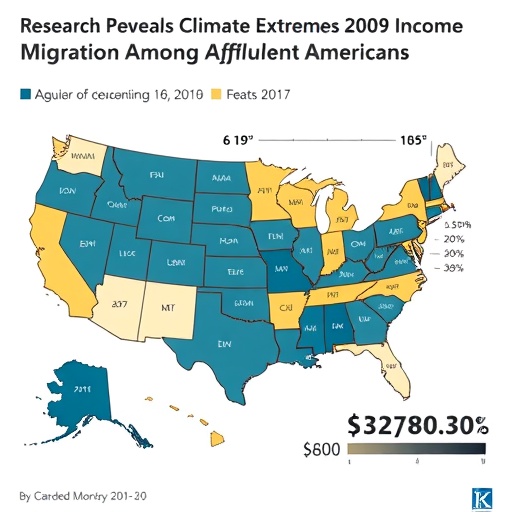In recent years, the intensification of climate-induced disasters has compelled communities across the United States to confront a profound dilemma: whether to rebuild in place after catastrophic events or to relocate to safer, often higher, ground. The socio-economic implications of these decisions extend well beyond the immediate aftermath of disasters, reshaping demographic and economic landscapes in ways that are only beginning to be understood. University of Vermont researchers Mahalia Clark and Gillian Galford have embarked on an ambitious investigation into the complex relationship between extreme weather events and migration patterns, with a particular emphasis on the economic dimensions of such movement.
Clark and Galford’s research builds on their earlier work examining American migration trends over the past decade, now expanding the scope to evaluate how discrete categories of severe weather—such as floods, hurricanes, wildfires, tornadoes, and storms—interact with the flows of human populations and income. Unlike prior studies that often amalgamated these phenomena into a singular variable, their approach meticulously disaggregates the impacts of individual hazard types on migration, thereby revealing nuanced economic and spatial dynamics that vary significantly depending on the nature of the climatic event.
Utilizing anonymized IRS data from 2011 through 2021, the researchers analyzed household income alongside migration flows at the county level. They then integrated this socio-economic data with detailed property damage records from the SHELDUS database, managed by Arizona State University, covering severe weather destruction from 1995 to 2021. This synthesis provided an unprecedented lens through which to view the interplay between climate hazards and the socio-economic composition of affected communities.
One of the principal findings indicates that in the wake of hurricanes and floods, higher-income households exhibit a pronounced tendency to leave impacted areas at greater rates than their less affluent neighbors. This selective migration results in a transfer—or “exodus”—of wealth away from disaster-stricken communities and has profound implications for the economic resilience of these regions. As affluent residents relocate, they take with them vital financial resources, potentially undermining the local tax base necessary for effective recovery and future disaster preparedness.
Interestingly, the study highlights divergent responses to hurricanes versus floods. In hurricane-affected counties, both population and income migration trends decline, with shifts in the two dimensions rising and falling in tandem. However, the Northeast exhibits a more marked tendency for income to outpace population loss following hurricanes, signifying that wealthier households are disproportionately responsive to this threat. This phenomenon introduces spatial stratification that can exacerbate inequality, as less affluent populations are left behind in increasingly under-resourced locales.
In contrast, flood events appear to exert less influence on overall migration volumes. The number of households in flood-affected areas remains relatively stable, with those who depart generally replaced by incoming residents. Yet, in terms of income, a net loss is observed following significant flood years—implying that those departing possess greater financial means than those arriving. The effect is less dramatic than with hurricanes but equally concerning from an economic equity perspective.
These patterns underscore a critical insight: economic capacity significantly informs individuals’ decisions to relocate post-disaster. Higher-income households possess the financial flexibility to make preemptive or reactive moves to safer environs, while lower-income residents are often constrained by economic, social, and institutional barriers. The resultant selective migration may deepen socio-economic divides, compounding vulnerabilities in communities that are already disproportionately exposed to climate risks.
Clark notes the importance of disentangling the effects of different hazard types on migration dynamics. By avoiding a monolithic treatment of extreme weather, the study reveals that neither wildfires, tornadoes, nor other storms generate migration and income shifts comparable to those triggered by hurricanes and floods. This finding suggests that the economic consequences of climate migration must be understood in the context of hazard-specific characteristics, such as geographic distribution, frequency, and intensity.
The ramifications of these findings extend to policymakers and planners charged with disaster response and resilience building. Recognizing that migration responses to climate hazards are unevenly distributed by income level should inform resource allocation, recovery investment, and long-term adaptation strategies. Clark emphasizes that supporting vulnerable populations’ ability to migrate away from high-risk areas may be as crucial as bolstering those who remain.
Looking ahead, the research team sees value in localized studies that can unpack socio-economic migration dynamics at finer geographic scales. Such work would offer critical insights into the intersection of climate justice, economic opportunity, and urban-rural shifts that are poised to reshape the American demographic mosaic under accelerating climate impacts.
Further support for this research trajectory is emerging at UVM through the establishment of the Climate Measurements Center of Excellence, directed by Galford. Situated within the Gund Institute, the center is dedicated to developing standardized, accessible tools for climate assessments across scales—from state to regional levels—enabling more precise identification of severe climate events and the human responses they engender. Such advancements promise to significantly refine our understanding of how income shapes migration and recovery in the face of mounting climate hazards.
The novel integration of socio-economic and climatic datasets demonstrated by Clark and Galford’s study marks an important advancement in climate migration research. Their work not only quantifies the extent of affluent outmigration from disaster zones but also highlights the perilous economic consequences for those who remain behind. As climate change intensifies, confronting this income-based divergence in migration responses will be essential for crafting equitable and effective policy interventions that safeguard all Americans from the escalating threat of natural disasters.
Subject of Research: The interaction between climate hazards, human migration, and household income in the United States.
Article Title: Exodus of the affluent? Examining climate hazards, migration, and household income in the U.S.
News Publication Date: June 25, 2025
Web References:
- https://doi.org/10.1007/s11111-025-00496-5
- https://www.uvm.edu/gund/news/study-wealthy-americans-flee-floods-and-hurricanes-driving-income-migration
- https://www.uvm.edu/gund/climate-measurements-center-excellence
References:
Clark, M., & Galford, G. (2025). Exodus of the affluent? Examining climate hazards, migration, and household income in the U.S. Population and Environment. https://doi.org/10.1007/s11111-025-00496-5
Keywords:
Climate change, Extreme weather events, Migration, Income migration, Floods, Hurricanes, Socio-economic impacts, Climate adaptation, Disaster recovery, Household income, Population dynamics




